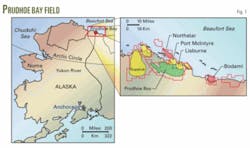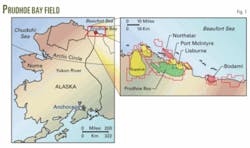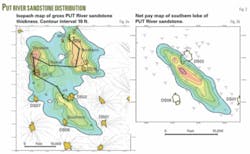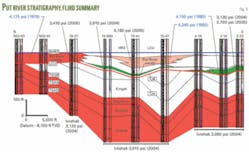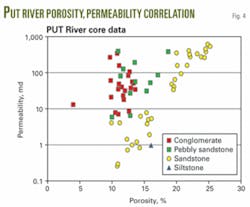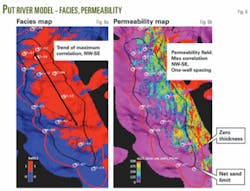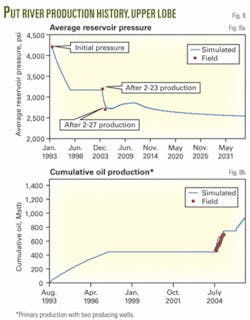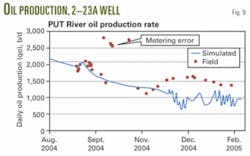BP is developing a minor sand reservoir in the Prudhoe Bay field after appraising the potential by recompleting existing wells, building 3D stochastic reservoir models, and running VIP simulations. BP began production of the southern lobe of the Putuligayuk (PUT) River in late 2006.
This article includes a brief background of the Putuligayuk (PUT) River reservoir, including geological description and production history. It’s followed with an analysis of the flow simulation work undertaken to design the pattern flood at PUT River.
The concluding article (OGJ, July 28, 2008) will describe a top-down reservoir modeling process (TDRM) used to assess the impact of reservoir uncertainty on ultimate oil recovery.1 It also presents the field implementation of the pattern flood, along with field observations.
Minor reservoirs
Minor reservoir sands, which we define as those with original oil in place (OOIP) of less than 50 million stock tank bbl (MMstb), frequently occur in or near large fields. Developing such sands when the major fields are mature offers an incentive because production facilities usually are readily available and underutilized. However, it’s difficult to develop minor sands economically. The uncertainty in reservoir parameters must be fully evaluated before implementing any development planbefore any cost is incurredsince even a slight error in uncertainty assessment can make the field development program uneconomic.
The PUT River sand is a minor reservoir with four identified lobes in the Prudhoe Bay field.
The southern lobe, with an estimated OOIP of 12.6-19.2 MMstb, is the most suitable sand for development. Only a few wells can be economically justified, however, as few as one to two new wells or as many as five recompletions of existing wells. The proposed location of the new wells is critical.
In addition to location and siting, well performance will also depend on the rock quality, structural style and its impact on fluid flow, and proper reservoir management (pressure maintenance, etc.).
To mitigate the prospect of low recovery because of the uncertainty in reservoir parameters, we developed a comprehensive reservoir analysis, including a detailed geological study (chronostratigraphic study) to assess the paleodepositional system including sediment flow direction. This assists in positioning the new wells to optimize oil recovery. Seismic analysis helped determine the impact of faults on sand continuity.
We used the sand continuity analysis results and logs from existing wells to construct a fine scale geostatistical reservoir model, which formed the basis for numerical flow simulation. The team generated a large number of simulation models that incorporated uncertainties of major parameters.
Flow simulation using these models provided data for reservoir benefit analysis. Based on the analysis of the simulation results, we planned two producers and an injector in the PUT River reservoir with an option to add two more producers in the future.
PUT River
The PUT River sandstone is located on Alaska’s North Slope within the Prudhoe Bay Unit (Fig. 1). It overlies the Kingak shale and Sadlerochit Group near drillsites 1, 2, 5, 6, 7, 15, 18, NGI, and WGI.
The PUT River sandstone, along with the Kalubik formation (shale and siltstone), is part of the PUT River interval that lies stratigraphically above the Lower Cretaceous unconformity (LCU) and below the highly radioactive zone (HRZ).
Four vertically significant and laterally extensive sandstone bodies (or lobes) have been correlated within the PUT River interval. They are termed the southern, central, western, and northern lobes of the PUT River sandstone (Fig. 2). The appraisal data indicate that the four lobes are isolated reservoirs with different fluids and pressures.
Only the southern lobe contains an undersaturated black oil accumulation. Only the southern block will be produced as a part of the PUT River development. The Northern lobe encompasses the entire PUT River interval. The remaining three lobes are stratigraphically equivalent to the Northern lobe and interbedded with the Kalubik formation.
PUT River consists of two sand packageslower sand A and upper sand B. Sand B is up to 75 ft thick and encompasses the western lobe of the PUT River sandstone. To the south the distal portion of the B sandstone correlates to thin sandstone and siltstone beds. The Northern lobe of the PUT River sandstone consists of both the A and B sandstones.
A-sand is divided into two sub-sands, A2 and A4. The A2 sandstone lies directly on the LCU and is thickest in the south. The southern lobe of the PUT River sandstone entirely consists of the A2 sandstone where it is up to 41 ft thick. The A4 sandstone is separated from the A2 sandstone by a thin shale and siltstone layer. The A4 sandstone is thickest within the Midfield graben (up to 22 ft thick). The central lobe of the PUT River sandstone entirely consists of the A4 sandstone.
Lithology
The sandstone in the southern lobe (subject of this article) is a medium-grained, moderately to well-sorted, chert-lithic arenite with localized pebble layers. The detrital mineralogy is predominantly quartz and chert, with minor amounts of feldspar and fine-grained lithic fragments. Glauconite occurs as disseminated and granular accumulations in concentrations up to 15%.
Clay content is largely associated with the finer-grained and poorly-sorted intervals; it is not pervasive through the matrix. Beds generally fine upward and bioturbation is common. Visible porosity ranges from 10-20% with little pervasive cementation. Quartz overgrowths occur on most grains, with quartz cement best developed in well-sorted sandstone beds. Siderite cement occurs locally mostly near the top and base of the A2 sandstone reducing the rock permeability.
Structure
The PUT River interval is bisected by the Midfield graben structure. The Midfield graben has resulted in a number of potentially isolated compartments within the field, especially in the western lobe. The northern and southern lobes are also faulted, but the vertical throw of these faults is small and likely does not result in significant reservoir compartmentalization.
Fig. 3 is a north-south oriented structural cross-section along the axis of the western and southern PUT River lobes. This figure shows the overlying and underlying stratigraphy as well as the fault complexity of the area.
Rock, fluid properties
We used available core data and well log control to estimate the rock properties and net sandstone volume of the PUT River sandstone. Fluid properties were determined from PVT analysis of downhole and surface samples from wells 02-23A, 15-09A, 15-41B, and 18-27C.
The team estimated rock properties, including porosity, permeability, and water saturation of the A2 sandstone using a petrophysical log model calibrated to the core data from well 02-14. Fig. 4 shows the correlation between porosity and permeability for the PUT River A2 sand.
The Southern lobe contains black oil. We evaluated reservoir fluid properties using a downhole oil sample collected from well 02-23A. The bubblepoint pressure was 2,815 psia. The API gravity was 26.9° with a solution gas-oil ratio (GOR) of 548 scf/bbl. The formation volume factor was 1.293 reservoir bbl/stock-tank bbl with an oil viscosity of 1.84 cp at 3,190 psia and 181° F.
In the southern lobe, the initial reservoir pressure was 4,163 psia, based on the 1980 RFT in well 02-14. The pressure of the PUT River sandstone in this lobe has been reduced by production from the 02-27 and 02-23A wells. The current reservoir pressure is 2,710 psia, based on a March 2005 buildup test in well 02-23A. The reservoir temperature is 182° F.
The southern lobe was produced for a short period in 2005 to gather data and collect fluid samples. Fig. 5 presents the relevant production data.
Characterization, simulation
The team modeled reservoir development options for the southern lobe of the PUT River sandstone.
We built a fine-scale reservoir model for the southern lobe of the PUT River reservoir using a geostatistical method. The general workflow to build a typical reservoir model follows an iterative process to achieve a reasonable history match.
We used log data from 14 wells to condition the reservoir properties. Fault data were obtained from the interpretation of the seismic data. Seismic data show that there are numerous mappable faults in the southern lobe. Most of the mappable faults in the main part of the lobe are small, however, except one toward the southwest edge of the lobe.
Fig. 6 shows fine-scale facies and permeability distribution obtained from the geostatistical model.
We modeled two facies: sand (facies 1) and shale (facies 0). Facies 0 is nonproductive. Permeability and porosity have a maximum correlation in NW-SE direction. This is surmised from the analysis of deposition style of the sand in the existing wells. A vertical trend derived from the existing well data was also used to condition the rock properties. The well data show that the midsection (~20 ft) of the sand is good quality and becomes sideritic towards the top and the bottom of the sand.
Fine-scale data were scaled up to simulation grid scale with a pressure solver. Plots of the scaled-up porosity and permeability distribution from the simulation model show that permeability and porosity decrease both westerly and downward. This trend matches the observed trend in the well data.
A Monte Carlo simulation run helped to determine the range of spread in the original oil in place (OOIP). Fig. 7 summarizes the Monte Carlo simulation output. The most likely OOIP in the southern lobe of the PUT River reservoir is 18.3 MMstb, which compares favorably with the OOIP of the geostatistical model (18.8 MMstb).
History match
The geostatistical reservoir model was used to history-match the limited field data using Landmark’s VIP finite difference simulator. The simulation model has 23 grid cells in X and Y direction and 25 layers. The grid cell dimension is about 1,000 ft in the X-direction and about 500 ft in the Y-direction. The layers are about 2 ft thick.
Relative permeability curves for Kuparuk River sands are used in the simulation run.2 PVT data are from an oil sample from the well 2-23A.3 We used a constant initial water saturation of 35% in the model, and set the initial pressure to 4,163 psia.
Fig. 8 displays the field average pressure and cumulative oil production match. Fig. 9 presents a comparison of oil production rates for the well 02-23A. Figs. 8 and 9 show that the simulation results match favorably with field data. Some of the variation in matching 02-23A oil rate is caused by metering error.
We also conducted a forecast run on primary oil recovery in two existing producers, 02-23A, and 02-27. The oil production rate and cumulative oil recovery data indicate that ultimate oil recovery is marginal under primary mode.
A more prudent approach to PUT River reservoir development will be to implement secondary pressure maintenance through a balanced waterflood. The target average reservoir pressure should be above the bubblepoint pressure to limit the release of solution gas from the oil in the reservoir.
References
- Williams, G.J.J., Mansfield, M., MacDonald, D.G., and Bush, M., “Top-Down Reservoir Modeling,” SPE 89974, 79th Annual Technical Conference, Houston, Sept. 26-29, 2004.
- Ma, T.D., and Youngren, G.K., “Performance of Immiscible Water-Alternating-Gas (IWAG) Injection at Kuparuk River Unit, North Slope, Alaska,” 69th SPE Annual Technical Conference, New Orleans, Sept. 25-28, 1994.
- Application for Amendment of Conservation Order No. 341D for the Prudhoe Oil Pool and Area Injection Order No. 4C to include the Put River Sandstone, Aug. 19, 2005.
Based on a presentation to 2008 SPE Western Regional meeting, Bakersfield, Mar. 31-Apr. 2, 2008.
The authors
Manmath N. Panda ([email protected]) is a senior reservoir engineer at Petrotechnical Resources of Alaska, currently a consultant in the western regional development group of BP Alaska. Previously, he worked as a senior reservoir engineer for ARCO Exploration and Production Technology. Panda holds a B. Tech (1984) from the Indian School of Mines, Dhanbad; an MS (1988) from the University of Alaska at Fairbanks; and a PhD (1994) from the University of Texas at Austin, all in petroleum engineering. He is a member of the SPE.
James A. Dean ([email protected]) is a petroleum engineer and subsurface team leader for BP in Anchorage. His current focus is infill development at Prudhoe Bay. Dean’s experience includes drilling, reservoir, and production engineering in the Gulf of Mexico and onshore US. He holds a BS (1994) in petroleum engineering from Texas A&M University and is a member of SPE.
Jeff Pietras ([email protected]) is a geologist for BP in Houston. He has worked on projects spanning from basin access and exploration to reservoir appraisal and production. Pietras specializes in cross-disciplinary integration to provide subsurface solutions at all scales. He holds a BS (1996) from Binghamton University and an MS (1998) and PhD (2003) from the University of Wisconsin-Madison, all in geology, and he is a member of AAPG and GSA.
Tami Wheeler ([email protected]) is a reservoir engineer for BP Exploration’s GPB gravity drainage group in Anchorage. Her current role is field development for Prudhoe Bay and Midnight Sun fields. Wheeler holds a BS (1983) in petroleum engineering from Texas A&M University and is a member of SPE.
Roger Sels ([email protected]) is a staff geologist-senior grade, currently working on development projects in the Prudhoe Bay field area. He attended undergraduate school at Occidental College in Los Angeles, and graduate school at the University of Oklahoma. Sels is a member of AAPG.
